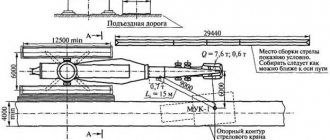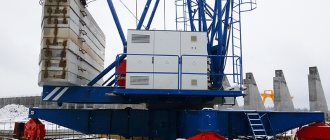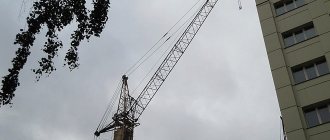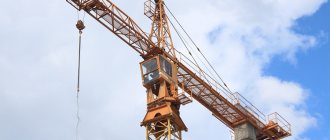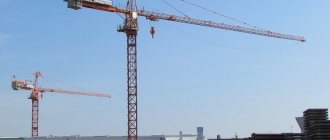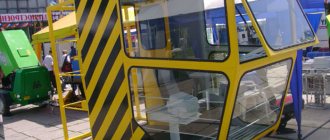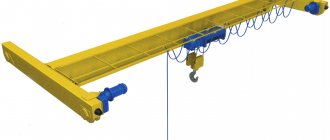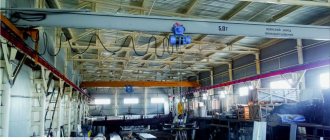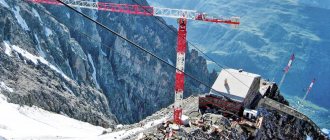Areas of application for mini cranes
Mini cranes are universal special equipment that cope with complex tasks in various areas. The machines operate in places where it is difficult or impossible to use other lifting equipment.
In addition, they are designed not only for lifting loads. There are models that can move materials around the site over short distances. Such vehicles are called load-carrying vehicles.
The mini crane is widely used. He works:
- indoors, in tunnels, underground parking lots;
- in limited spaces: under arched structures, narrow courtyards, on floors during the construction of structures;
- during the work of laying pipes and communications supplying the building with drinking water;
- on the glazing of houses, including high-rise buildings. In this case, additional equipment is used - special vacuum grippers;
- for installation of finishing panels, elevators, ventilation systems;
- in cottage and low-rise construction, incl. houses made of timber and logs;
- at industrial enterprises for moving and lifting materials in the workshop;
- in warehouses where there is little space for larger equipment, but there are heavy loads;
- when repairing large special equipment and vehicles, for example, airplanes, ships.
What it consists of and how it works
Lifting cranes are powerful and mobile construction devices.
The main purpose of the equipment is the mechanization of processes during the construction of high-rise and multi-story buildings, the movement of materials and parts of structures to storage points or construction sites.
In mechanical engineering, a tower jib crane is a structure with a rotating tower and a long boom, which is secured at the top with hinges.
The structure of a tower crane looks like this:
- tower;
- portal frames;
- rotary support device (ROD);
- rotating platform;
- arrow;
- head, or hinged posts;
- cargo and trolley winches;
- running trolley;
- lifting device;
- counterweight consoles and struts;
- cabin.
The main processes performed by the manipulator:
- moving the load to the desired height;
- reducing or increasing the reach of the boom mechanism with load-handling suspension;
- full boom rotation 360°;
- movement around the site of a self-propelled vehicle.
They are equipped with a multi-motor drive with a planetary gear operating on alternating current with a voltage of 220/380 V.
The cranes are designed as follows.
The main part of the structure is the tower - a frame for holding the boom element at the required height and transmitting horizontal and vertical loads to the running portal with wheels and crane rail tracks. Stability and resistance to wind loads are checked by calculations when designing a metal structure and are ensured by rigid fastening to the portal frame or installation of diagonal braces to the rotating platform for articulated rotation. In the manufacture of the tower, steel angles and pipes are used.
A boom made of large steel profiles is mounted to the top of the tower crane.
The running frame is an important element that absorbs the operating loads and transfers them to the crane tracks.
An assembly unit is attached to the rotating platform to transmit the load moment and carry out rotational-translational operations. On top of the tower there is a head, rigidly connected to the control center. On the opposite side of the beam there are counterweight consoles and winches.
To grab the load, the manipulator is equipped with a hook suspension.
Steel ropes are traction connectors for loads with block and drum devices, and high-strength pulleys. With their help, the mechanisms are rotated, the tower and cargo trolley are moved along the consoles, and the crane is installed.
The cabin is built inside the tower or taken outside, suspended from the top or rested on the portal platform. The front and side windows open. The soft, comfortable seat moves along guides along the room, turns, lowers and rises.
The control and measuring equipment is located on the internal panel:
- command controllers;
- overhang limiter;
- tonnage controller;
- electronic anemometer;
- emergency switch;
- signaling devices.
The cabin has storage space for things, a first aid kit, tools and a technical magazine, a ventilation system and a heater, lighting panels and a fire extinguisher are attached.
Technical specifications
Some models of small cranes do not have their own traction motor. Therefore, for movement, they are equipped with rubber or polyurethane wheels or are stationary. However, among the representatives of mini-cranes there are self-propelled models. They are, for the most part, tracked. Moreover, their caterpillar tracks are rubber, which allows them to move freely on any surface, including concrete floors of buildings.
Many mini cranes are equipped with electric motors. This is what explains the widespread use of these machines indoors.
Let's put aside the design features of this type of machine; the main technical characteristics of mini cranes are the same as those of their larger counterparts:
- Load capacity;
- Boom reach;
- Load height characteristics.
For small cranes, overall dimensions, type of equipment and the ability to work in difficult conditions are of great importance.
What types of mini cranes are there?
Despite the fact that mini cranes themselves represent a separate type of lifting equipment, they have their own classification. Conventionally, they can be divided into:
- small lifting mechanisms;
- mini lifting cranes, manipulators;
- mini spider cranes;
- construction compact cranes.
Small lifting mechanism
The carrying capacity of the former is small. They are used mainly in car services and industrial enterprises. Most of them are stationary lifting mechanisms, although there are also mobile ones. This type, in particular, includes jib cranes.
Stationary mini cranes for lifting loads are a vertical column or support that is attached to a concrete floor or a separate foundation. A beam (boom) is attached perpendicularly to it. A hoist with manual or electric control is installed on the boom. Instead of a vertical column, this mini crane can be mounted to a wall, a building support, or even to the side of a machine.
Some models are made with a hinged boom attachment to the base. This design uses a hydraulic cylinder as a drive, which lifts the boom. This solution is especially effective when you need to lift heavy loads using a mini crane. Such mechanisms have high tearing force.
Mobile models of small lifting mechanisms have a wider base (usually pyramidal) and are equipped with wheels for moving the structure. They are transported from place to place mainly by hand. A trolley or trolley can be used as a base. The wider the base, the longer the boom and the higher the lifting capacity.
Mini-lifting crane, manipulator
A mini crane for lifting loads is a mobile reloading device (MDU) or, in other words, a gantry crane. Unlike their larger counterparts, mini gantry cranes do not move on rails and guides, but are often a single U-shaped structure mounted on wheeled supports. However, their operating principle is the same: a carriage with a winch is installed on the beam, which, due to an electric drive, lifts and lowers loads.
A special place is occupied by crane-manipulator installations. Many of them are smaller copies of conventional CMUs. However, due to their size, they are usually not mounted on the base chassis. These models of mini cranes are installed in the back of trucks and can be quickly dismantled. Mini cranes are convenient because they can be moved from one vehicle to another or used as a stationary mini crane.
Spider Crane
Separately, it is worth highlighting the spider crane. It got its name because of its appearance. The design of this crane includes four articulated outriggers with telescopically extendable supports. They are very reminiscent of insect paws.
The advantage of this design solution is that the spider crane can easily be installed on a staircase, in an arch or above a trench. The main thing is that an operator can approach the machine to control the mechanisms. In addition, they are usually mounted on a tracked base and are capable of moving around the site under their own power.
It is worth noting
that the smallest crane in the world is Unic URW-A094CR
This type of crane is actively used inside buildings, for glazing and finishing facade panels of houses and cottages, in areas with uneven surfaces.
Construction compact cranes
The use of mini cranes in the construction sector is driven by work in tight spaces. Also, the use of large machines in the construction of cottages and private homes is sometimes not economically feasible. However, high-end mini cranes operate on construction sites. Most of them are mobile, which does not always mean mobile.
For example, there are models of compact, pre-fabricated cranes that cannot independently move around a construction site. They are firmly installed on the site. But the time it takes to transfer them from working to transport position takes literally a few minutes. And the base for them is a regular car trailer.
Otherwise, a mini crane for construction is a compact, crawler-mounted lifting equipment. Models on pneumatic wheels are less common due to the specifics of the work - the tracked base gives more stability, and the speed of movement does not play a big role. After all, due to its small dimensions, such equipment is transported in the back of a truck or in a trailer.
Selecting a tower crane depending on operating conditions
First of all, when choosing a tower crane, you should take into account the construction conditions.
High rise construction
During high-rise construction, specially created tower cranes are used: free-standing or on an anchor base, which are equipped with a tower self-extension mechanism, and can also be attached by a tower to the structure being built. Of course, in this case, you can only use tower crane models that have a top rotation, that is, a non-rotating tower.
Photo source: xcmg.com.ru During high-rise construction, specially created tower cranes are used
The maximum height of a free-standing or rail-mounted crane with a lifting capacity of 8 to 10 tons is 70 meters. Therefore, if the height of the building exceeds 70 meters, it is necessary to give preference to a crane with an anchor base and attached to the structure.
Read: Buying a tower crane: quality or efficiency?
In addition, the higher the height of a free-standing tower crane, the greater the cost of weighting and strengthening the structure. In this regard, tie-down cranes, which are attached to a building during its construction, are now being used more and more often: the weight of this equipment is significantly lower, and the operating area is expanded not due to the movement of the crane, but by increasing the length of the boom.
Low-rise construction
In low-rise construction, either the types of cranes indicated above or any others are used - here the choice of a tower crane depends on the conditions and parameters of the construction site. Hydraulic self-expanding cranes are currently popular, the maintenance of which does not require high-altitude licenses, and can be operated by one person.
Monolithic or panel construction
Today, monolithic housing construction is being used more and more often. And there is a high probability that panel construction will be forced out of the market by monolithic construction. Currently, most construction companies during the construction of monolithic buildings use stationary concrete pumps in conjunction with hydraulic self-elevating distribution booms, due to which the task of delivering concrete is removed from the tower crane.
Photo source: sd-tehno.ruAn important characteristic of the crane is the speed of lifting the load to a height
There is an opportunity to opt for a cheaper crane, the average lifting capacity of which is 4-6 tons. In this situation, the heaviest part to be lifted will be the formwork panel, the maximum weight of which is about 300 kg. Therefore, you should purchase a crane that has a known higher lifting capacity at maximum hook reach (approximately 1,000 kg).
Of course, energy consumption and price for equipment of smaller standard sizes can be several times lower. There is an opportunity to save money on the purchase of a concrete pump, high-quality formwork, tools - something that increases construction efficiency.
In the case when during monolithic construction the “bell” method of pouring concrete is used, when choosing a tower crane it is necessary to pay attention to such a characteristic as the speed with which it will lift the bucket of mortar to the required height. After all, at a low lifting speed, the solution in the tub can harden. Pouring concrete in a “bell” manner negatively affects the quality of the monolithic structure being erected and reduces the cost-effectiveness of construction, since a heavy tower crane is expensive. Characterized by high energy consumption, construction time increases. The structure of a tower crane wears out faster, which is caused by the regular movement of extremely heavy materials.
Photo source: alfacranes.ru Wear on a tower crane increases due to the regular movement of extremely heavy materials
The use of a concrete pump allows you to compensate for the shortcomings of the “bell” and increases the efficiency of monolithic construction.
Minor loading operations
Panel housing construction is used, as a rule, only in the countries of the former USSR. At the same time, panel construction is tied to house-building plants and is very ineffective at a great distance from them. The choice of crane for panel construction depends on the maximum weight of the panel structures, so heavy tower cranes with a lifting capacity of 8 to 10 tons are required, which are characterized by high cost and high energy consumption.
However, most often when choosing a tower crane, the determining circumstances are rare minor loading operations, such as unloading bundles of reinforcement, the weight of which is 8-10 tons. Or the installation of ready-made heavy concrete blocks, which constitute less than 1% of the total number of structures, although they can be produced on site using modern formwork. Therefore, in this situation, heavy tower cranes are mistakenly preferred, resulting in unnecessary construction costs.
Popular models of mini cranes
Maeda is one of the leaders in the global market for small cranes. According to analysts, its share in the spider segment reaches 60% as of 2022.
Among the Maeda models, it is worth noting the cranes of the MS line, equipped with a cable remote control system. The most popular are the spiders MC 285 and MC 305, with a load capacity of 2.82 and 2.98 tons, respectively. Maeda cranes are powered by a Yanmar diesel engine and an electric motor for indoor use.
Another leader in the spider segment is the Italian company ORMET, which offers a wide range of machines under the Jekko brand. The models include both spiders and mini crawler cranes. The lifting capacity of Jekko cranes is from 1.2 to 4 tons, lifting height is 7.2-16.5 meters. Some models are equipped with a rigid jib.
Author: Anton Panov
Share

